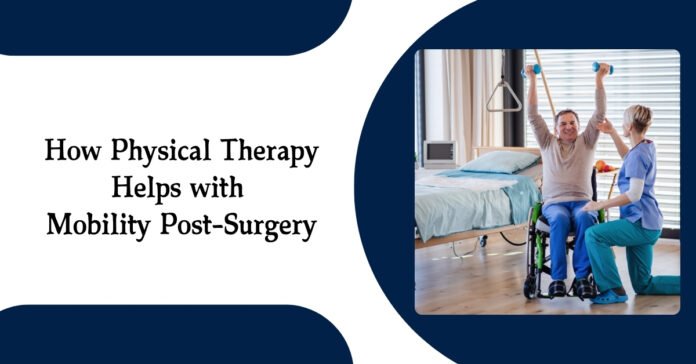After undergoing surgery, regaining mobility is often a primary concern for patients. Whether it’s a knee replacement, amputation, hip surgery, or any other procedure, physical therapy in the recovery process. Understanding the importance of effective rehabilitation can help patients regain their independence and improve their quality of life. Explore how physical therapy aids in recovery, the techniques involved, and the benefits of seeking professional help.
Understanding The Importance Of Mobility Post-Surgery
Mobility refers to the ability to move freely and easily, which can be significantly affected by surgery. Post-surgical mobility is essential not only for physical health but also for emotional well-being. Limited mobility can lead to complications such as muscle atrophy, stiffness, and psychological issues like anxiety or depression. Physical therapy is designed to address these concerns, providing a structured approach to recovery.
The Role Of Physical Therapy In Recovery
1. Assessment and Personalized Treatment Plans
One type of physical therapy is a thorough assessment of the patient’s condition. Physical therapists evaluate strength, flexibility, and range of motion to develop a personalized treatment plan tailored to the individual’s needs. This plan typically includes specific goals, such as improving balance, increasing strength, and enhancing overall mobility.
2. Restoring Strength and Flexibility
Post-surgery, patients often experience weakness and stiffness in the affected area. Physical therapy involves targeted exercises designed to restore strength and flexibility. For instance, after knee surgery, therapists may guide patients through exercises that focus on strengthening the quadriceps and hamstrings, essential muscles for walking and climbing stairs.
3. Pain Management
Pain is a common experience after surgery, and it can significantly hinder mobility. Physical therapists utilize various techniques to manage pain, including manual therapy, modalities like heat or cold therapy, and specific exercises that promote blood flow and reduce discomfort. These methods help patients feel more comfortable and capable of engaging in their rehabilitation exercises.
4. Balance and Coordination Training
Maintaining balance and coordination is for preventing falls, especially in post-surgical patients who may be unsteady on their feet. Physical therapists incorporate balance training into their sessions, using tools like balance boards and stability exercises to help patients regain their confidence and stability as they move.
5. Physical Therapy for Amputees
Physical therapy for amputees is a specialized type of rehabilitation designed to help individuals adapt to life after losing a limb. It focuses on improving strength, balance, and mobility, teaching amputees how to use prosthetic limbs effectively and regain independence in daily activities.
Through exercises and personalized care, physical therapy helps amputees restore movement, reduce pain, and build confidence in their physical abilities, ultimately improving their quality of life. Prosthetic devices help individuals adapt to life after limb loss, allowing them to regain independence and confidence in their daily activities.
Effective prosthetics are designed to provide comfort and functionality, making it easier for amputees to engage in rehabilitation exercises and everyday tasks. Seeking support from a prosthetic leg manufacturer in India can ensure that the prosthetic solutions are tailored to meet individual needs, promoting a smoother transition to life with a prosthesis.
6. Education and Empowerment
An essential component of physical therapy is educating patients about their recovery process. Understanding what to expect and how to manage their rehabilitation empowers patients to take an active role in their recovery. Therapists provide guidance on proper body mechanics, safety precautions, and lifestyle modifications that can enhance healing and mobility.
The Benefits Of Early Intervention
Starting physical therapy as soon as it is deemed safe post-surgery can lead to faster recovery times and better outcomes. Early intervention helps to minimize complications and encourages patients to regain their mobility sooner. Here are some of the significant benefits:
1. Reduced Risk of Complications
Engaging in physical therapy early on can significantly reduce the risk of complications such as blood clots, pneumonia, and pressure ulcers. By promoting movement, patients are less likely to experience these post-operative issues, leading to a smoother recovery.
2. Improved Outcomes
Research has shown that patients who participate in physical therapy after surgery experience better outcomes, including higher levels of satisfaction with their recovery and an increased ability to return to daily activities. Comprehensive care helps ensure that patients achieve their recovery goals.
3. Psychological Benefits
The psychological benefits of physical therapy cannot be overstated. Engaging in regular therapy sessions provides patients with a sense of accomplishment as they progress in their recovery. Additionally, the support and encouragement from therapists can alleviate feelings of isolation or anxiety, contributing to overall emotional well-being.
When To Seek Help From A Physical Therapist
It’s for patients to work with a qualified physical therapist throughout their recovery process. Patients should seek professional help if they experience:
- Persistent pain that interferes with mobility
- Difficulty performing daily activities
- Increased swelling or stiffness in the surgical area
- A lack of progress in recovery after several weeks
Working with an experienced physical therapist is essential for guiding patients on their journey to recovery, ensuring that they regain their strength and mobility effectively.
Empowering Recovery: The Transformative Impact Of Physical Therapy
Physical therapy is a vital component of post-surgical recovery, offering numerous benefits that aid in restoring mobility and improving overall quality of life. Through personalized treatment plans, strength and flexibility training, pain management, and education, physical therapists empower patients to take charge of their rehabilitation.
By prioritizing physical therapy in your post-surgical recovery, you can achieve your mobility goals and return to the activities you love.

